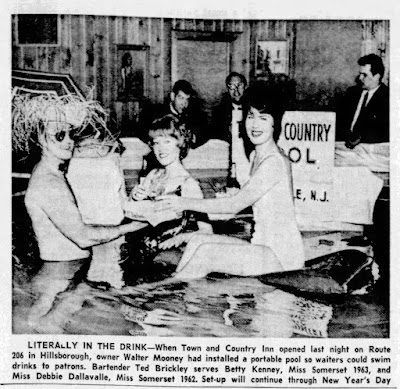
You can read about the history of Three Towers here. Now let's put the rest of it in order with this brief survey of the other nine businesses that called the southbound side of Route 206 in "South Somerville" home.
Town & Country Inn (1958 - 1969)
After a run of bad luck and other incidents that caused Three Towers to acquire, in the words of one Hillsborough Township Committeeman, "a bad reputation" subsequent owners Joseph and Margaret Hazy closed the 27-year-old restaurant/ballroom/catering hall and sold the business to Walter B. Mooney in February 1958. Mooney renovated the ballroom and opened up as Town & Country Inn.
 |
| 9 May 1958 Courier News |
Contemporary newspaper advertisements inform us that Mooney attempted to repeat the early success of Three Towers. Square Dancing was out and the big bands were back including Guy Lombardo and his Royal Canadians for Town & Country's first anniversary in 1959 and the sweet trumpet of bandleader Charlie Spivak and his orchestra in 1961.
Remember gentlemen: "Jackets are in order".
 |
| Town & Country Ads 1958 - 1963 |
By cleaning up the place Mooney - who lived in the rooms above the hall - won back the local politicians and was even appointed to Hillsborough's Industrial Commission.
 |
| 28 October 1965 Courier News |
In the mid-sixties, the Central Jersey Bachelors' Association sponsored two dances each week. Friday nights were more formal with "jackets and ties required" while Wednesday evenings were casual affairs - sometimes a prize would be awarded for the most casual outfit!
 |
| 27 December 1963 Home News |
Duke's Farm Inn (1969 - 1972)
Rudolph Esposito was a Manville trucking company owner whose family also happened to be in the restaurant business. He initially bought the Town & Country Inn and changed the name to Duke's Farm Inn with the idea that he could get away from serving Italian food. However his customers had other ideas, and he was compelled to bring their favorite Italian dishes to the menu.
 |
| 10 October 1969 Courier News |
 |
| Duke's Farm Inn ads 1970-71 |
The Jolly Ox (1972 - 1983)
Steak and Ale was a restaurant chain that started in Texas in 1966. For certain jurisdictions that didn't allow an alcoholic beverage (ale) to be in the name, they operated as The Jolly Ox. Hillsborough's Jolly Ox opened on December 1, 1972.
 |
| 27 November 1972 Courier News |
The restaurant featured the standard Steak and Ale fare with daily specials - Tuesday might be shrimp scampi, Wednesday, prime rib, etc. With the large banquet facilities, the Mazurs were able to do the kinds of weddings that other restaurants in the Steak and Ale family couldn't attempt.
 |
| 17 July 1979 Courier News |
 |
| 18 December 1981 Courier News |
Jaspers (1983 - 1996)
Charlie Moore and Jim Richards - who became friends when they were students at the Culinary Institute of America - opened the original Jaspers in Raritan in 1980. Located on Route 206 near Sherman Avenue the 55-seat restaurant was their first business venture together. Just 24-years-old at the time, the two said their cuisine was heavily influenced by a backpacking trip they had taken together through Europe.
 |
| 26 Dec 1991 Courier News |
In August 1983 they brought their European-inspired veal, chicken, and seafood dishes to the much larger Hillsborough premises. They kept the restaurant in Raritan, renaming it Donovan's.
 |
| Jaspers Ads 1995 and 1985 |
 |
| June 1987 Courier News |
Although maybe not as well-remembered by "old-timers" as The Jolly Ox or Town & Country, Jaspers thirteen years in business remains second only to Three Towers in the 90-year history of restaurants at that location.
Jersey Jim's Brewing Company (1996 - 2001)
After running Jaspers successfully for thirteen years, Richards and Moore began to feel increased competition from the growing number of national chain restaurants moving into Central Jersey. Instead of selling out, they thought about changing to a themed restaurant - maybe a sports bar, or a country-western place. Ultimately they hopped onto the 1990s microbrewery bandwagon and opened Jersey Jim's on April 12, 1996.
 |
| Jersey Jim's 1996 ads |
The Pavilion (2001 - never opened)
Instead of pining for the old days when they could celebrate important events at Jasper's, Janis and Marty Wolfson and their partners Karen and Bill Hendriksen decided to do something about it. In 2002 they began a renovation of Jersey Jim's to bring back the ballrooms of old as The Pavilion. Their plan was to be primarily a banquet facility while also opening as a restaurant on special occasions such as Mother's Day.
 |
| 21 February 2002 Courier News |
Shogun (2003 - never opened)
In 2003, Richard Lee - the owner of the Shogun restaurant on Route 22 in Green Brook - bought the property with plans to turn it into another Shogun.
 |
| 21 December 2003 Courier News |
Coccola (2006 - 2009)
After Richard Lee declined to pursue turning the building into a Shogun restaurant the site was dormant for another three years. Then experienced area restauranteurs Nino and Janet Tamburin (Eccola in Parsippany, Eccoqui in Bernardsville) were taking a drive down Route 206 and found the property to be "eye-catching". They began another renovation of the building to turn it into an upscale Italian-American restaurant.
 |
| 6 January 2006 Courier News |
 |
| 23 June 2006 Courier News |
Maestro 206 (2010 - 2013)
There was no big renovation before Maestro 206 took over the site in 2010. It seems like they moved right in.
 |
| 18 March 2014 Courier News |
Favorites (2017 - present)
And speaking of Favorites, that's the name of the restaurant that includes off-track-wagering that currently occupies the site. As their history is still being written, I will leave it for another time.































